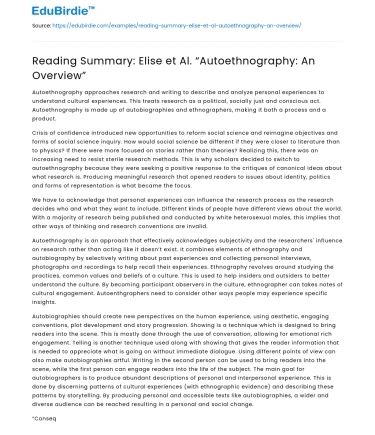Autoethnography approaches research and writing to describe and analyze personal experiences to understand cultural experiences. This treats research as a political, socially just and conscious act. Autoethnography is made up of autobiographies and ethnographers, making it both a process and a product.
Crisis of confidence introduced new opportunities to reform social science and reimagine objectives and forms of social science inquiry. How would social science be different if they were closer to literature than to physics? If there were more focused on stories rather than theories? Realizing this, there was an increasing need to resist sterile research methods. This is why scholars decided to switch to autoethnography because they were seeking a positive response to the critiques of canonical ideas about what research is. Producing meaningful research that opened readers to issues about identity, politics and forms of representation is what became the focus.
Save your time!
We can take care of your essay
- Proper editing and formatting
- Free revision, title page, and bibliography
- Flexible prices and money-back guarantee
We have to acknowledge that personal experiences can influence the research process as the research decides who and what they want to include. Different kinds of people have different views about the world. With a majority of research being published and conducted by white heterosexual males, this implies that other ways of thinking and research conventions are invalid.
Autoethnography is an approach that effectively acknowledges subjectivity and the researchers' influence on research rather than acting like it doesn’t exist. It combines elements of ethnography and autobiography by selectively writing about past experiences and collecting personal interviews, photographs and recordings to help recall their experiences. Ethnography revolves around studying the practices, common values and beliefs of a culture. This is used to help insiders and outsiders to better understand the culture. By becoming participant observers in the culture, ethnographer can takes notes of cultural engagement. Autoenthgraphers need to consider other ways people may experience specific insights.
Autobiographies should create new perspectives on the human experience, using aesthetic, engaging conventions, plot development and story progression. Showing is a technique which is designed to bring readers into the scene. This is mostly done through the use of conversation, allowing for emotional rich engagement. Telling is another technique used along with showing that gives the reader information that is needed to appreciate what is going on without immediate dialogue. Using different points of view can also make autobiographies artful. Writing in the second person can be used to bring readers into the scene, while the first person can engage readers into the life of the subject. The main goal for autobiographers is to produce abundant descriptions of personal and interpersonal experience. This is done by discerning patterns of cultural experiences (with ethnographic evidence) and describing these patterns by storytelling. By producing personal and accessible texts like autobiographies, a wider and diverse audience can be reached resulting in a personal and social change.
“Consequently, writing personal stories can be therapeutic for authors as we write to make sense of ourselves and our experiences (Kiesinger, 2002; Poulos, 2008), purge our burdens (Atkinson, 2007).” (280)
Aside from writing being therapeutic for the writer, it can provide just as much benefit for the reader. Betty Friedan’s writings were able to give white middle-class women a voice when it comes to the lack of personal development they experienced. Since they never talked about these issues with other people, these writings talked about it for them. Friedan's' writings sparked a cultural change in society's understanding of women's rights and their feelings of isolation and discontentment.
This ties into issues of validity for autoethnography. Validity means that when the reader is engaging with the text, they can relate and believe it. In some cases, readers can also feel validated through certain texts or displays of ethnographic work. Autoethnography can also improve the lives of readers, by describing their personal experiences.
I find the points made about auto ethnographers and their writings being both beneficial to the writer and the reader. The writer can articulate their thoughts, trying to make sense of their experience, while the reader simultaneously possesses a feeling of validation, relatability, and personal development. The example highlighted about Betty Friedan writing helping the public of white middle-class married women, stuck out to me. It is quite similar to autobiographies and writings that I’ve read during in my life. Reading interviews and autobiographies on black female artists such as Mickalene Thomas, Dorothy Dandrige and August Savage evoked an emotional response in me. Reading their stories and experiences of trying to be successful in a creative industry as a black woman I realized that I also shared these experiences as well (or should at least prepare for them). As the reader, I felt validated and was able to use their experiences to help me navigate my way into this industry as I got older. I'm positive that the other millions of young black girls reading about these powerful women also experienced a similar feeling.






 Stuck on your essay?
Stuck on your essay?

